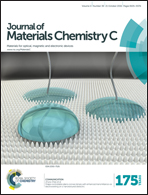Direct observation of structural transitions in the phase change material Ge2Sb2Te5†
Abstract
Phase change memory, which is based on the reversible switching of phase change materials between amorphous and crystalline states, is one of the most promising bases of nonvolatile memory devices. However, the transition mechanism remains poorly understood. In this study, via in situ transmission electron microscopy with an externally applied DC voltage and nanosecond electrical pulses, for the first time we revealed a reversible structural evolution of Ge2Sb2Te5 thin films from an amorphous state to a single-crystal state via polycrystals as an intermediate state. This transition is different from the traditional understanding of structural changes in Ge2Sb2Te5, i.e., from an amorphous structure to a hexagonal close-packed structure via face-centered cubic as an intermediate structure. In situ observations indicate that this poly-to-single crystal structural transition is caused by coalescence of neighbouring grains induced by an electric field, in which a fast heating/cooling rate is found to be essential. Our study opens a new avenue for the realization of the multi-level operation of phase change materials.


 Please wait while we load your content...
Please wait while we load your content...